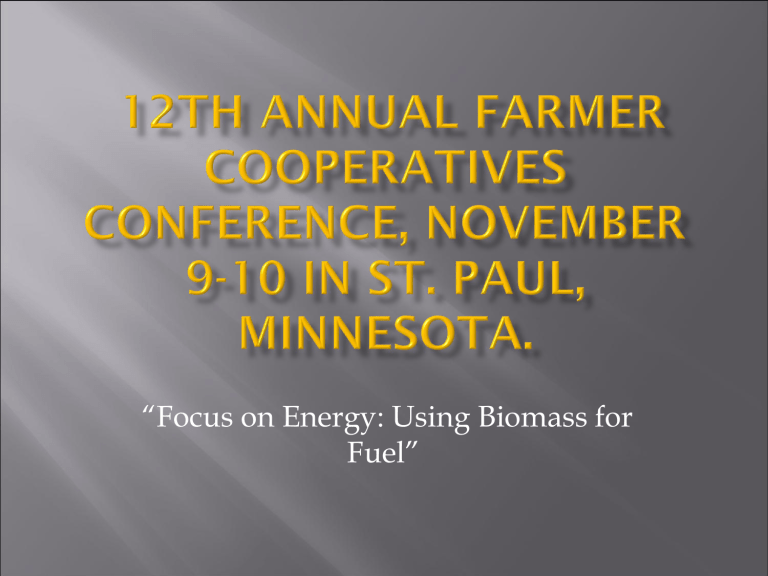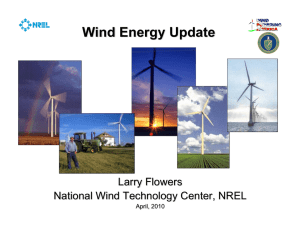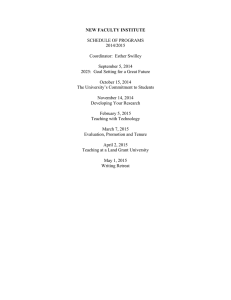Johnson Inbicon

“Focus on Energy: Using Biomass for
Fuel”
Making ethanol work for the world.
™
Larry Johnson
Business & Project Development
Collection Handling Storage
“Green Energy” Mandates www.dsireusa.org
☼
WA:
OR
15% by 2020*
: 25% by 2025
MT: 15% by 2015
(large utilities
5% - 10% by 2025 (smaller utilities)
)*
ND: 10% by 2015
SD: 10% by 2015
MN: 25% by 2025
(Xcel: 30% by 2020)
VT: (1) RE meets any increase in retail sales by 2012;
(2) 20% RE & CHP by 2017
MI: 10% + 1,100 MW by 2015*
WI : Varies by utility;
10% by 2015 goal
☼ NY: 24% by 2013
☼ NV : 25% by 2025*
CA: 20% by 2010
☼ AZ:
UT: 20% by 2025*
15% by 2025
☼
☼ CO: 20% by 2020 (IOUs)
10% by 2020 (co-ops & large munis)*
NM: 20% by 2020 (IOUs)
10% by 2020 (co-ops)
IA:
KS: 20% by 2020
☼
105 MW
☼ IL:
MO: 15
☼
OH : 25% by 2025 †
25% by 2025
% by 2021
WV: 25% by 2025*
VA: 15% by 2025*
†
☼ NC : 12.5% by 2021 (IOUs)
10% by 2018 (co-ops & munis)
☼ PA: 18% by 2020
☼ NJ: 22.5% by 2021
☼ MD: 20% by 2022
☼
☼
ME: 30% by 2000
New RE: 10% by 2017
☼
☼
RI: 16% by 2020
CT: 23% by 2020
DE:
DC:
NH:
MA:
23.8% by 2025
15% by 2020
+ 1% annual increase
(Class I Renewables)
20% by 2020
†
20% by 2019*
TX: 5,880 MW by 2015
HI: 40% by 2030
29 States have an RPS
6 states have goals
State renewable portfolio standard
State renewable portfolio goal
Solar water heating eligible
☼
Minimum solar or customer-sited requirement
*
†
Extra credit for solar or customer-sited renewables
Includes non-renewable alternative resources
BioFuels Production and RFS2
Development and consumption of biomass by DONG Energy starting from
1989.
Inbicon’s raw material know-how:
DONG Energy’s 100% biomass-fired power plant.
368MMDT/Y - Forest Products
998MMDY/Y- Agricultural
1,368,000,000 Total Dry Tons Available
Potential for > 100 Billion Gallons of Ethanol
Woody Biomass
Designated Energy Crops
MSW and Industrial Wastes
Crop Residues
Lumber Harvest Residues
Milling Byproducts
Tree Plantations
Orchard Trimmings
Forest Management
Urban Green Wastes
Sorghum
Sugarcane
Miscanthus
Switchgrass
Poplars/Willows
Algae
Exotics
Grain Processing Byproducts
Industrial Wastes
Consumer Wastes
Food and Beverage Byproducts
Wheat and Barley Straw
Rice Straw
Corn Stover
Corn Cobs
Bagasse
Grasses
Straw/Stover/Cob
Inbicon Biomass
Refinery lignin 50MT/hr (20Mgpy)
Steam Power
Ethanol
C5 Molasses
Multi-fuel (as req’d)
On-Site
CHP Plant
Steam
Power
Energy Reduction of
50-100%+
Existing
100Mgpy
Grain-based
Ethanol Facility
1,200 MT/day – 20Mgpy
Baler from Krone capable of pressing
4’X4’X8’ bales weighing about 1300 lbs.
Tarp Covering U.S.
Wheat Straw Storage: Stokervarme, DK
Property (%bdb) Corn Stover
ASH CONTENT
CELLULOSE (C6 sugars)
HEMI‐ CELLULOSE
CONTENT (C5 sugars)
LIGNIN CONTENT
8.13%
37.49%
26.54%
16.74%
Corn Cobs
3.78%
43.50%
36.50%
11.60%
Higher capital costs
Lower operating costs
Very clean product
Contains all the cobs
Reduced volume per acre
Less moisture control
Compliments farmers’ schedule
Lower capital costs
Higher operating costs
May contain 10% dirt
Contains very few cobs
Greater volume per acre
More moisture control
Requires farmer scheduling
One Pass Stover Bale with Cobs
One Pass System
200,000 acres @ 2.5 tons/acre
500 farmer contracts @400 acres/farmer
Each contract will have options/variables
$15 million in inventory @ $30/ton
250 acres for storage sites
800,000 bales @ 13 pound density
20,000 bales/day in a 40 day harvest season
555 semi-loads per day @ 36 bales/load
50 balers required @ 100 acres/day
What does the plant need?
Cob/stalk ratio
What will the plant accept?
Moisture content
What is the pricing formula?
Contract specifications
Use GIS analysis and regional crop history
Coordinate radius with road delivery system
Estimate tons harvested per acre
Calculate % of total available acres needed
Defined 25 mile radius of selected plants
Tracking of biomass bales per field
• Feedstock Supply Analysis
• Create Procurement Company
• Develop Procurement Model
• Initiate Procurement Contracts
• Define Collection and Storage Logistics
• Implement Program
Procurement and delivery contracts
Define logistical and timing details
Credit-worthy feedstock supplier
Financing of procurement company
Staffing - personnel
Equipment requirements
Deposit on farmer contracts
feedstock payment
Fuel purchase and storage
Regional Storage Sites
Insurance
Host plant subsidiary
Farmer owned cooperative
Independent company
Identify and contact growers
FCS office (USDA)
Host plant customers
Grain elevators
Farm groups and associations
Local weather reporting system
GPS field locations
ID and quantify product at harvest
Match harvest with each contract
Identify and coordinate storage sites
Federal (BCAP)
State (Economic Development)
Local (TIF – Utilities)
Form a local advisory committee
Identify and contact growers
FCS office (USDA)
Host plant customers
Grain elevators
Farm groups and associations
Negotiate harvest schedule with growers
Quality control and land use details
Incentives and penalties
Payment guarantees
On farm storage where applicable
Full time staffing activities
General Mgr. and CFO (1)
Office and clerical (1)
Acquire and service contracts (3)
Scheduling and coordinating harvest (1)
Staff hiring and training (1)
Manage harvest crews (1)
Equipment maintenance (2)
Fuel supply infrastructure (1)
Manage feedstock inventories (1)
Part time staffing (harvest)
Harvest and collection (~50)
Trucking from field to storage (~45)
Manage fuel delivery (1)
Collect and coordinate data (~5)
Miscellaneous “Gofer” (1)
Identify all growers within a plant radius
Conduct grower informational meetings
Negotiate and sign contracts for delivery
Balers, semis, loaders, stackers, wagons, fuel trucks, choppers, windrowers
Purchase
Lease
Custom Contract
Harvesting: Balers, Tractors, Loaders
Trucking: To Plant and Regional Storage Sites
Stacking: Roadside and Regional Storage
Grading and Drainage
Road Access
Zoning and Permitting
Roadside storage
Farmer storage
Tempering
Bale covering
Weighing and accounting
Field location and harvest date
Bale count, moisture and density
Ownership recording and receipt
Reconciliation with Contract
Storage site destination
Inventory Management
Storage specifications
Fire Protection
Transport from Storage to Plant
Permitting and Zoning
Dust Control
Feedstock Security
Can it be done?
Absolutely!
Will it happen?
Absolutely!
When will it happen?
When we get technology, government, and financing working together.
Making ethanol work for the world.
™



